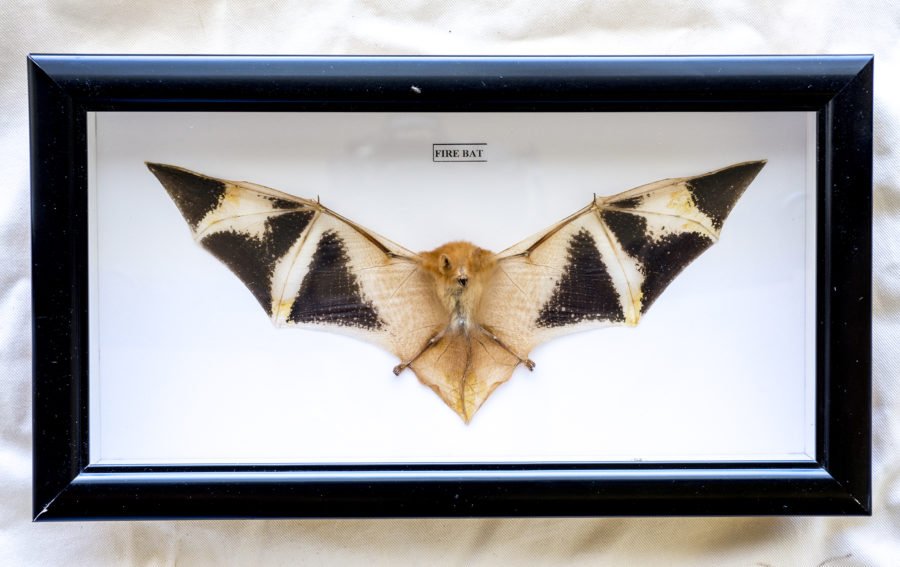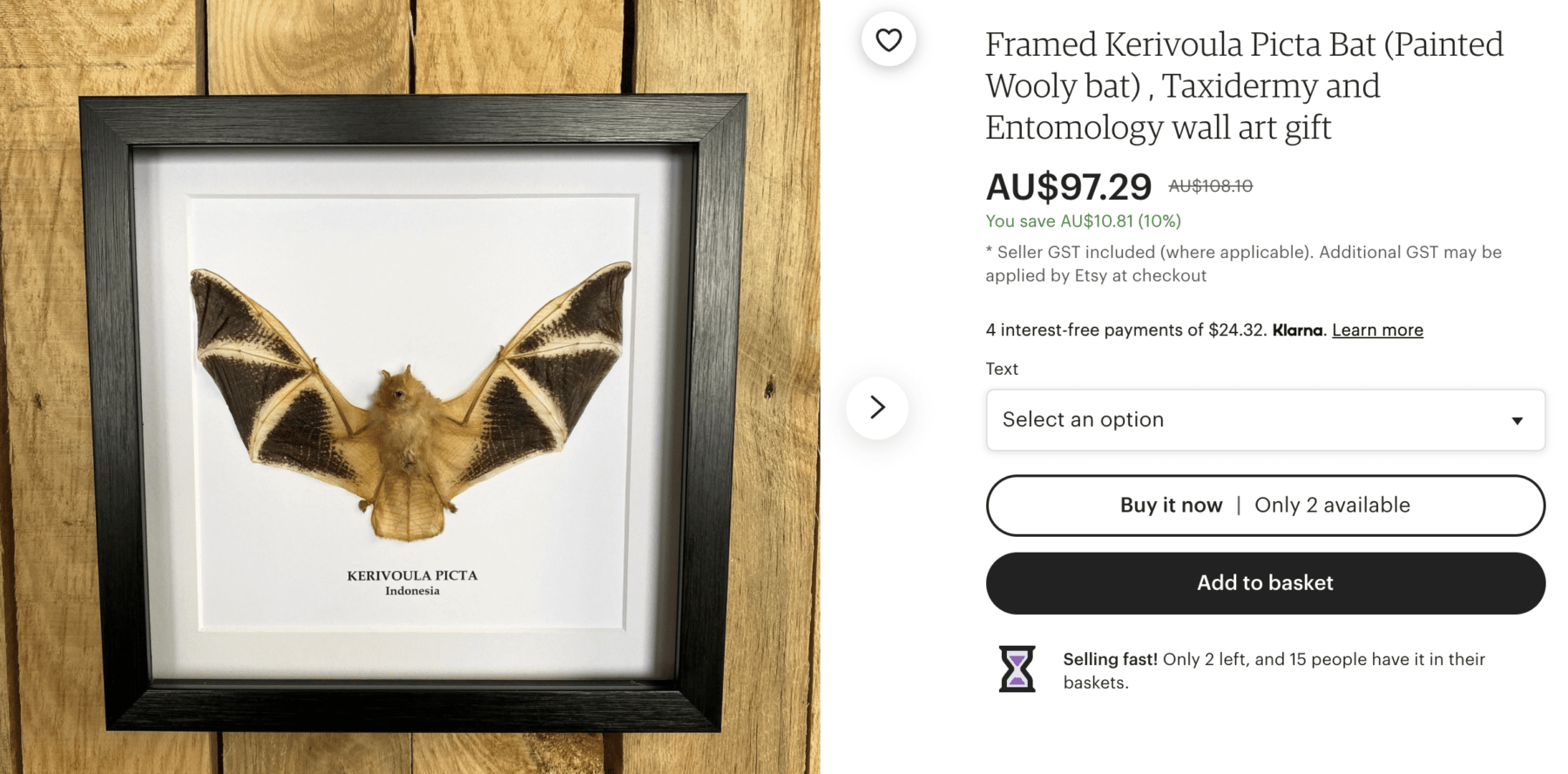Stop buying these bats, scientists and conservationists plead

You’d be hard-pressed to find a painted wooly bat (Kerivoula picta) in the wild. The International Union for Conservation of Nature lists it as ‘near threatened’ and reports that populations are either on the decline or ‘unknown’ worldwide. Where you will see the painted wooly bat, however, is on sites such as Etsy and eBay selling for less than $100.
Little is known about the bat souvenir trade. A recent study by veterinary scientists from the University of Adelaide found the majority of the microbats being sold online came from South-East Asia. Out of the 32 species for sale, researchers say some are listed, internationally, as vulnerable, near threatened or critically threatened.
“I was surprised by the volume of bats, the species available and how cheap they were,” says Dr Anne-Lise Chaber, a lead author of the study. While the paper answered questions around what’s available on these platforms, exactly how the bats end up there remains a mystery. Many of the sellers on Etsy claim that the bats are ethically sourced. Some go further, including a certificate of ‘responsible origin’.
Bat conservationist and ecologist Jasmine Vink doesn’t buy it. When Jasmine began messaging bat taxidermy sellers about the origins of the specimens, she encountered a wide-range of responses. “A lot of them were outright lies,” she says. “They don’t need anything to back up their claims. People assume that it’s the truth. When I started asking them more pointed questions they’d say the bats were bred in captivity to be used for taxidermy.” This is impossible, Jasmine says.
“It’s really difficult to breed bats in captivity. They only have 1–2 babies a year. They need specialist care. It would not be economical to breed them in captivity. When I asked where the facilities are and whether they had photos of the set up they’d say, ‘We don’t give information out about our sources’.” Another common response Jasmine received was that the bats were found already deceased. “Occasionally, you may find a relatively intact bat that has already passed but to find these fresh, completely intact and in large numbers is impossible.”
Anne-Lise believes it’s likely the bats are being poached from the wild. “It’s very unlikely they’re breeding bats, they just have to go to the caves to get them. You can breed bats, but it requires important infrastructure that’s very costly. The mean price for bat taxidermy is $AUS38. That means it’s not something that costs them a lot and that’s why they can sell it at that price.”
When sold online many of the bats have been placed inside a frame against a white background with their common and scientific name written below them. According to Anne-Lise, many of the descriptions were incorrect. “We found that 30 per cent of the bats were mislabeled with the wrong species or wrong genus. If you don’t even have the correct name of the species how can they actually say the bat was legally taken?”

Health concerns
The COVID-19 pandemic has revealed the worldwide impacts of wildlife trade. Anne-Lise believes that the health concerns that come with the trade of bat taxidermy are slipping under the radar. “It’s unlikely people are wearing protective equipment when they’re catching these bats. They could be scratched and bitten or could make contact with blood or saliva and that’s a source of a zoonotic disease.”
There’s also concern for the way the bats are being prepared. “The taxidermy process is not explained in most cases, and from what we can see, the bats are being dried, rather than going through the full taxidermy process. The bat taxidermy should be assessed and made sure that the animal has been processed in a way that prevents the transmission of pathogens. Due to the volume of things coming through the post it makes it very difficult to enforce.”
The impact on bat populations
According to the IUCN, the painted wooly bat “is currently threatened by a large demand for its dry specimen and skulls as tourism souvenir and ornament accessories in both physical shops (locally and in foreign countries) and online worldwide.” Most of the species recorded for sale in Anne-Lise’s study roost in caves. “There are so many in one spot, so it’s really easy to catch them and you can see a major decline in populations very swiftly.”
CITES (Convention on International Trade in Endangered Species) is a treaty that regulates the international trade of endangered species, both dead and alive. Among the bats listed on eBay were the Javan slit-faced bat and the straw-coloured fruit bat, which are listed under Appendix II of CITES. Species listed under Appendix II are not currently threatened with extinction, however trade must be closely controlled. Sellers must have an export permit. “We didn’t see any CITES papers for any bats,” says Anne-Lise. “If you have them you should be able to provide it.”
Brett Cox, Assistant Secretary Trusted Trader and Trade Compliance at Australian Borderforce says that if CITES-protected species arrive at the Australian border they require both an export and import permit. Those without the necessary declarations will be seized and the buyer contacted.
“It’s on both parties,” Brett says. “If you’re buying to import, you absolutely should be asking the people who are selling it to produce the export permits from their country and you need to be applying for a permit to bring it in. You need to make sure the paperwork is government paperwork, and not just a random statement.”
Anne-Lise wants online retailers to stop selling taxidermy bats altogether. “I think that animals alive or dead shouldn’t be sold on international online platforms, as it likely makes it easier to elude many CITES or biosecurity regulations all over the world. This unnecessary wildlife trade is creating a risk to both biodiversity and public health.”
While many of the taxidermy bats sold online are listed as ‘least concern’ by the IUCN, conservationists are worried that because bats can only produce one or two young a year they are vulnerable to any kind of commercial harvesting. The diadem leaf-nosed bats and Leschenault’s rousette were among the top three most available on eBay at the time of the study, and both only produce 1–2 young annually.
A spokesperson for eBay said the online marketplace only allows the domestic sale of items on Appendix II where export documents are not applicable and prohibits the sale of items on CITES Appendix I.
“eBay is committed to animal welfare and the protection of native, endangered and threatened species. This means products from endangered or protected species can’t be listed by sellers,” the spokesperson said.
“We work closely with government agencies and NGOs globally to prevent illegal wildlife trafficking on our site and will review any items reported to us to ensure compliance with our policies and relevant laws.
“Globally, in 2020 eBay blocked 257,000 listings that violated our prohibited wildlife policies.”
Etsy was approached for comment.

